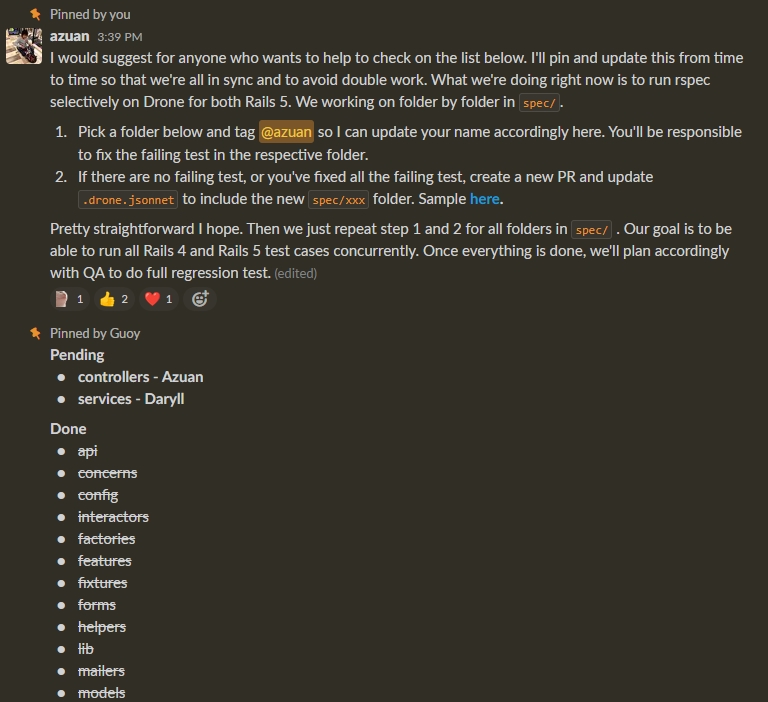In Fave, we are still largely powered by our majestic monolith Ruby on Rails app. On 3rd November 2021, we finally reached a big milestone and upgraded our app from 4.2 to 5.0!

Initially, we wanted to upgrade earlier. However, the priority changed. Truth is, it took us around 3 years and 3 months before we finally finished the upgrade. What gives? I’m hoping to share our Rails upgrade journey and why it took us so long to reach here.
1. Dual boot
When we first started the project, our naive solution was to create a pull request and slowly update the codebase to make it compatible with both versions of Rails. However, it started to get bigger and getting harder to do code reviews.
Reading on how Github does it helps us a lot in this case. Moving forward, we decided that dual boot is how we can incrementally update our codebase. Using next_rails gem is not necessary but it does make it easier for us.
if Fave.next?
# code for Rails 5.0
else
# code for Rails 4.2
end
2. Gems
Gems are one of my favorite things about Rails. There’s a gem for almost everything. However, left unchecked, it can cause different issues.
In our case, having too many gems make it hard for us to upgrade our Rails app. Some gems are no longer maintained, and some have too many dependencies.
In our journey to upgrade our app, we decided that sometimes it’s easier to remove a gem than to upgrade it. Less is more. When we need to upgrade a particular gem, do it one gem at a time so it’s easier to keep track of the changes.
3. Forks
Sometimes, there are cases where we decided to fork certain gems and customize them to our workflow. Most of the time we realized that we didn’t keep our fork up to date with the upstream. Outdated forks are risky and it’s hard for us to move and upgrade our codebase.
The solutions here are not easy. If we do need to fork a repo, our best option here is to always keep it up to date with the upstream. Monkey patch might not be a popular option, but if we can manage it right, it’s a lot easier than maintaining a fork. Each solution has its pros and cons.
4. Negotiating priorities
Engineers love to talk about technicalities. We love it too much that sometimes we forgot not everyone understands the technical jargon that we are using.
When we couldn’t explain in simple words why we need to upgrade Ruby on Rails, our team might not understand
the importance of it. Instead of saying we need to upgrade Rails because we can use ActionCable, we can try to reword it to with the new Rails version, it will be easier for us to add real-time features to our app.
When we can’t explain it in simple terms, it’s harder for others to truly understand what are our goals and objectives. And it’s hard to prioritize something that not everyone understands.
Communication is the key here.
5. Help others to help you
For our Rails upgrade, we created a Slack channel to have a discussion and gather people for the project. I remember being so enthusiastic about the project and I was so sure that people would love to be involved in it.
A few weeks after we started the project, we barely got any help. Took me a while, but I decided to try a different approach and posted this on the Slack channel.

What I did was create specific instructions on what kind of help we need, and how exactly can others help. In less than a few weeks, we managed to fix all of our tests and run both Rails 4 and 5 on our CI. Turns out, people were excited about the project. They’re just not sure how can they contribute.
6. Have a plan
When we first started, we have a rough idea of what we were trying to do. However, it wasn’t final. Now that we’ve done it, all that’s left is just to document our steps and keep improving them. This is what it looks like for us now:
1. Setup dual boot for current and next Rails.
2. Run both Rails versions in CI
i. Current Rails version must always be green.
ii. Next Rails version is allowed to fail until we fix all the errors.
3. All tests in CI must pass
4. Run a full regression test with our QA team.
i. Combination of both automated and manual testing.
5. Switch all staging servers to use the new Rails version.
6. Canary release on production.
7. Once everything is stable, remove the old Rails version from the codebase.
In the end, we were happy with the upgrade. Just like any other project, not everything is about coding and we certainly learned our lesson here. It was a long journey for us but it was worth it.